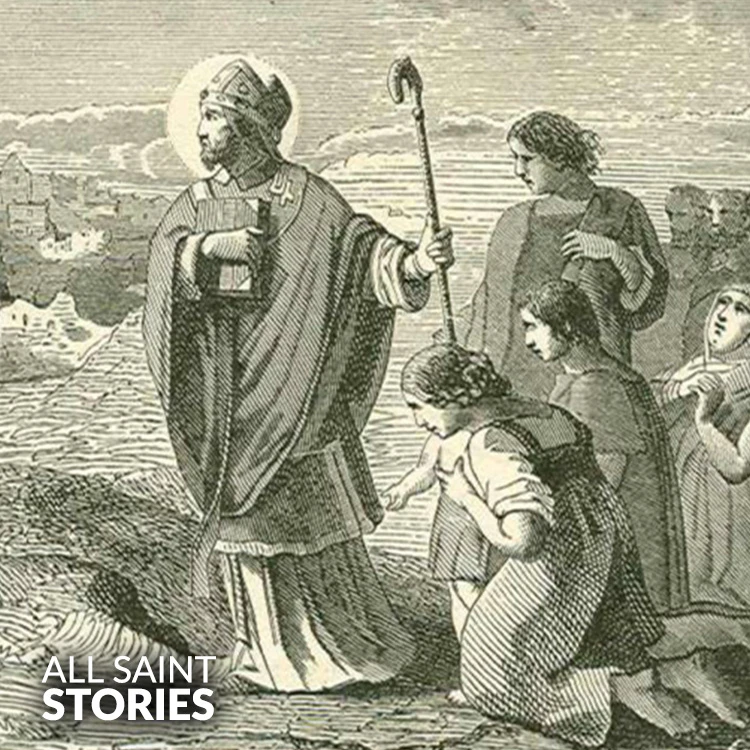O God, who called your servant Finbarr to preach the Gospel and build up your Church in the land of Ireland: Grant that we, inspired by his example and aided by his prayers, may grow in faith and proclaim your Word with courage. Through Christ our Lord. Amen.
ST. FINBARR
ST. FINBARR

St. Finbarr was a 6th-century Irish monk and bishop, best known as the patron saint of Cork. He founded a monastery that became the city’s spiritual center. His feast day is celebrated on September 25, and his legacy lives on through the cathedral named in his honor and the pilgrims who visit his hermitage at Gougane Barra.
St. Finbarr, also known by the Irish name Fionnbharra meaning “fair-headed,” was born around the year 550 AD near Bandon, in County Cork, Ireland. His original name was Lochán, and he was the son of a skilled artisan named Amergin from Galway. From a young age, Finbarr demonstrated a deep spiritual inclination and a thirst for religious knowledge. He pursued his religious education at Kilmacahil in Kilkenny, where he studied under prominent monks, eventually embracing the monastic life.
After completing his education, Finbarr undertook a significant pilgrimage that took him through Wales, where he visited the renowned St. David, and eventually to Rome. According to some legends, during a second visit to Rome, he was chosen to be consecrated a bishop. However, a divine vision revealed that only God could ordain him, and so Finbarr returned to Ireland spiritually consecrated, ready to fulfill his divine mission.
Finbarr’s most enduring legacy began when he founded a monastery in 606 AD on a limestone cliff overlooking the River Lee, at a place now known as Gill Abbey. This monastery served as a foundational center for what would eventually become the city of Cork. His influence extended beyond Cork, as he traveled across southern Ireland, evangelizing in places such as Gowran, Coolcashin, and Aghaboe. He was also known for his hermitage at Gougane Barra, a remote and peaceful area in the Cork mountains, where he lived a life of prayer and solitude before establishing his more public ministry.
According to legend, Finbarr was led by an angel from Gougane Barra, at the source of the River Lee, to its mouth. There he founded his monastery in the marshlands that would later become Cork. Another legend tells of him banishing a monstrous serpent named Lú from the lake at Gougane Barra, whose retreat carved out the riverbed of the River Lee.
St. Finbarr died in 623 AD in Cloyne, County Cork. His body was transported back to the city he helped to found, and he was buried in the cathedral he had established. Today, this site is known as St. Fin Barre’s Cathedral, one of the most iconic religious structures in Cork. The influence of his teachings also lives on in University College Cork, which honors him with the Latin motto "Where Finbarr taught, let Munster learn."
Pilgrimages to Gougane Barra still occur annually on the Sunday after September 25, where people gather to remember his life, seek spiritual renewal, and celebrate his contributions to Irish Christianity. Though the exact date of his canonization is not documented, his sainthood has been acknowledged for centuries within Irish religious tradition.
Video Not Found
No images uploaded for this saint yet.
The information on this website is compiled from various trusted sources. While we aim for accuracy, some details may be incomplete or contain discrepancies.
If you notice any errors or have additional information about this saint, please use the form on the left to share your suggestions. Your input helps us improve and maintain reliable content for everyone.
All submissions are reviewed carefully, and your personal details will remain confidential. Thank you for contributing to the accuracy and value of this resource.
Credits & Acknowledgments
- Anudina Visudhar (Malayalam) – Life of Saints for Everyday
by Msgr. Thomas Moothedan, M.A., D.D. - Saint Companions for Each Day
by A. J. M. Mausolfe & J. K. Mausolfe - US Catholic (Faith in Real Life) – Informational articles
- Wikipedia – General reference content and images
- Anastpaul.com – Saint images and reflections
- Pravachaka Sabdam (Malayalam) – Saint-related content and insights
We sincerely thank these authors and platforms for their valuable contributions. If we have unintentionally missed any attribution, please notify us, and we will make the correction promptly.
If you have any suggestion about ST. FINBARR
Your suggestion will help improve the information about this saint. Your details will not be disclosed anywhere.
© 2025 Copyright @ www.allsaintstories.com

 English
English
 Italian
Italian
 French
French
 Spanish
Spanish
 Malayalam
Malayalam
 Russian
Russian
 Korean
Korean
 Sinhala
Sinhala
 Japanese
Japanese
 Arabic
Arabic
 Portuguese
Portuguese
 Bantu
Bantu
 Greek
Greek
 German
German
 Dutch
Dutch
 Filipino
Filipino